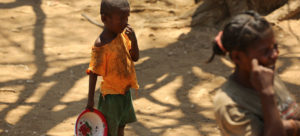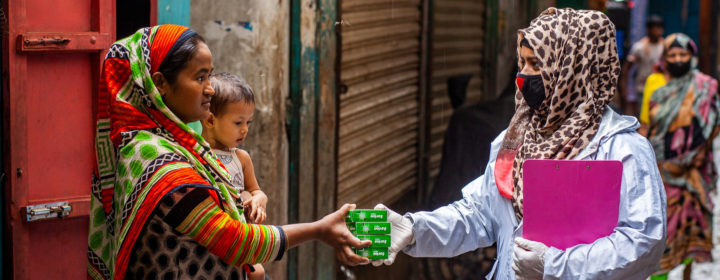Inequality between the rich and poor worsened during the COVID-19 pandemic and poverty increased, for the first time in decades. In part two of our series on how the virus has changed the world, we look at the ways the pandemic has pushed back efforts to create more equitable societies.
Inequalities exposed

© UNICEF/NahomTesfaye / Street vendors sell vegetables at a market in Addis Ababa, Ethiopia.
Over the past 12 months, COVID-19 has deepened those inequalities, a view highlighted in February, by the UN’s labour-focused agency, ILO, which declared that the two billion people working in the informal sector were particularly exposed.
In March, the agency followed up with projections which suggested that millions could be pushed into unemployment, underemployment, or the grinding condition of working poverty.
“This is no longer only a global health crisis, it is also a major labour market and economic crisis that is having a huge impact on people”, said ILO Director-General Guy Ryder. The agency published recommendations on ways to mitigate the damage to livelihoods, which included employee protection in the workplace, economic and employment stimulus programmes, and income and job support.
Keeping food supplies flowing
By April, the scale of global suffering became apparent, with a UN-backed report showing that poverty and hunger were getting worse, and that countries already affected by food crises were highly vulnerable to the pandemic. “We must keep critical food supply chains operating, so people have access to life sustaining food”, the study said, stressing the urgency of maintaining the delivery of humanitarian assistance “to keep people in crisis fed and alive”.
From using public transport as food hubs, traditional forms of home delivery, and mobile markets, communities have had to find innovative ways to feed the poor and vulnerable, whilst coping with COVID-19 restrictions on movement.
These are all examples of the ways that cities in Latin America rallied to support their populations, and reflect warnings from the Food and Agriculture Organization (FAO), that the health risk for many urban citizens is high during the pandemic, particularly the 1.2 billion who live in slums, and other informal settlements.
Women bear the brunt
“Women are bearing the brunt of the COVID-19 crisis as they are more likely to lose their source of income and less likely to be covered by social protection measures”. That was Achim Steiner, head of the UN’s development agency UNDP, noting the effect that the pandemic is having on women, pointing to data released in September.
It revealed that the poverty rate for women has increased by more than nine per cent, equivalent to some 47 million women: this represents a reversal of decades of progress to eradicate extreme poverty over the last few decades.
Phumzile Mlambo-Ngcuka, UN Women Executive Director, said that the increases in women’s extreme poverty are a “stark indictment of deep flaws” in the ways that society and the economy are structured.
Nevertheless, Mr. Steiner insisted that the tools exist to create a huge improvement to women’s lives, even during the current crisis. For example, more than 100 million women and girls could be lifted out of poverty if governments improve access to education and family planning, and ensure that wages are fair and equal to those of men.
One in six children affected

WFP/Tsiory Andriantsoarana / The combined effects of the drought, COVID-19 and the insecurity upsurge have undermined the already fragile food security and nutrition situation of the population of southern Madagascar.
Progress in reducing child poverty also took a hit this year. The UN Children’s Fund, UNICEF, and the World Bank reported in October that some 365 million children were living in poverty before the pandemic began, and predicted that those figures were set to rise considerably as a result of the crisis.
Extreme poverty deprives hundreds of millions of children of the opportunity to reach their real potential, in terms of physical and cognitive development, and threatens their ability to get good jobs in adulthood.
“These numbers alone should shock anyone”, said Sanjay Wijesekera, UNICEF Director of Programmes: “Governments urgently need a children’s recovery plan to prevent countless more children and their families from reaching levels of poverty unseen for many, many years.”
Aid for record numbers

IOM / A displaced family in Marib, Yemen, carries a winter aid package back to their shelter.<
By December, the UN was predicting that a record 235 million people would require humanitarian assistance in 2021, an increase of some 40 per cent on 2020 which is almost entirely a consequence of the pandemic.
“The picture we are presenting is the bleakest and darkest perspective on humanitarian needs in the period ahead that we have ever set out”, said the UN’s emergency relief chief, Mark Lowcock. “That is a reflection of the fact that the COVID pandemic has wreaked carnage across the whole of the most fragile and vulnerable countries on the planet.”
Mr. Lowcock warned that the scale of the challenges facing humanitarians next year are massive – and growing. “If we get through 2021 without major famines that will be a significant achievement,” he said. “The red lights are flashing, and the alarm bells are ringing.”
Time for a new global deal
At the end of the year, the UN chief issued a reminder that the levels of poverty and inequality seen this year are far from inevitable, and that a more equitable world is still possible, regardless of acute shocks such as the pandemic.
Speaking in December, Mr. Guterres expressed his hope that the pandemic could spark the transformations needed to achieve stronger social protection systems worldwide.
Reflecting on his comments on inequality made a year earlier, before the pandemic was on the horizon, the UN chief said that the world needs a new Global Deal, “where power, resources and opportunities are better shared at international decision-making tables, and governance mechanisms better reflect the realities of today”.






